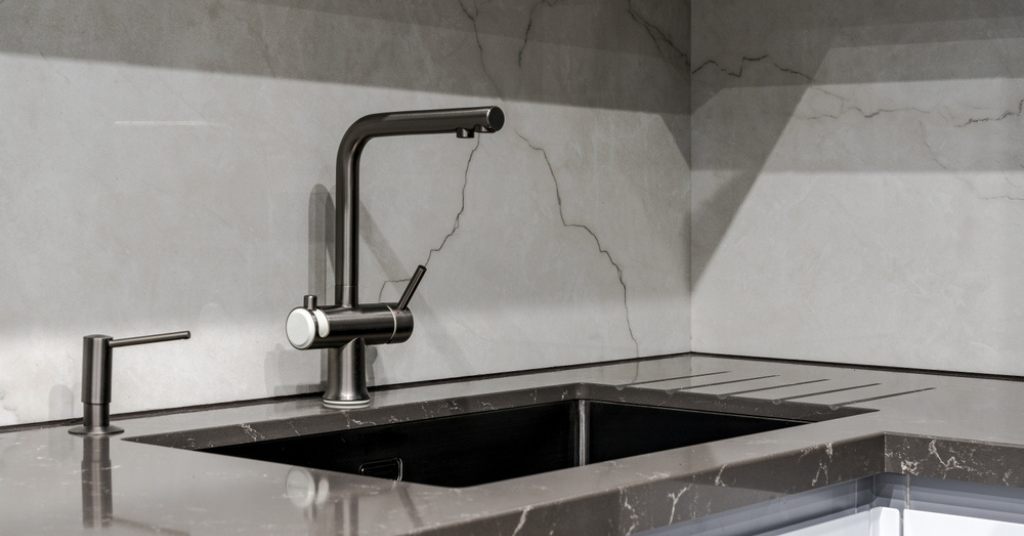
Imagine walking into a kitchen with dazzling interior design, finest cabinetry, and a shiny floor, what are the odds that your gaze will stumble upon the kitchen faucets? Probably a little less or maybe a lot more! But one thing’s certain—when the faucet cohesively complements the kitchen design or grabs attention as a statement piece, it’s hard to ignore. Therefore, it is crucial to choose high-quality kitchen faucets that not only enhance the kitchen functionality but also bring the bling to your eyes. After all, faucets are the real MVPs that bring freshness to your kitchen design and transform the visuals of the visible space.
So, let us get back to the basics, shall we? While choosing the right faucet for your kitchen, what is the first thing that comes to your mind? Most likely the proportionality of the faucet with the sink size and the design to some extent. While you are on the right track, there’s a lot more to consider – features, style, functionalities, and cost that are better suited for your kitchen.
George’s Showroom has some practical tips that will help you decide the right faucet for your kitchen that suits your aesthetic type, budget, kitchen dimensions, and the desired functionalities.
1. Type of Faucets
Before choosing the ideal faucet, consider the type that aligns better with your sink type and sinkhole configuration. Since faucets come in all shapes, sizes, colors, finishes, textures, and whatnot, you must consider certain aspects, primarily their design, functionality, and installation method. For instance, if you are confused about single or double-handle configuration, here is a tip! Single-handle faucets are easy to use and more suitable for limited spaces, while double-handle faucets provide flexibility for precise and better temperature control. Another careful consideration to make is the selection of the faucet’s mounting type. Whether you choose a deck-mounted, wall-mounted, or counter-mounted faucet, your choice should align with the overall design and kitchen functionalities. One component that a contemporary kitchen should not go without is the faucet with sprayers. It improves your maneuverability and helps you have steady control over the water flow. An added plus, sprayers are an eco-conscious choice as they are water-efficient and use comparatively less water as compared to traditional faucets.
Once you have chosen the faucet type, you must pay attention to its mode of operation. For hands-free operation, you can opt for touchless faucets powered by sensors. Then, there are varieties of touch-activated and manual faucets, which you can choose from based on functionalities, your sink area design, and your convenience. There are additional special features, such as bar faucets and kitchen pot filler faucets, that could be the best use case for your kitchen setup. Our featured brand, California Faucets, offers a great variety of kitchen pot fillers that can enhance your kitchen’s overall look and feel.
2. Types of Faucet Finish and Color
It is important to consider faucet finish as it impacts their appearance, maintenance over time, and overall kitchen aesthetics. While deciding which finishing style to proceed with, you must pay attention to the overall kitchen scheme and how well your faucet coordinates with other kitchen fixtures. Moreover, your choice of finish must align with aspects, such as durability, ease of cleaning, resistance to stains and rust, and longevity of the faucet. A diverse range of faucet finishes, including chrome, nickel, stainless steel, bronze, gold, brass, matte black, and more are available in the market. But what you choose should depend on your style, daily use, and the maintenance level you can commit to. For instance, California Faucets’ pot filler (Model: K30-200-FX-ABF) has all brass construction that makes it durable, and corrosion-resistant and ensures the faucet’s durability in high-moisture environments. Another popular choice of color and finish for kitchen faucets is chrome, a shiny silver finish that suits contemporary and traditional kitchens alike. Moreover, it is durable, easy to clean, and resistant to scratches.
3. Sink Hole Configuration and Other Requirements
Critical components that should be considered while choosing faucets for the kitchen are the number of holes and configuration of the sinkhole. It is most important when you are replacing your old kitchen faucets without altering the actual design. There are sinks with varieties, such as one-hole, two-hole, three-hole, and four-hole configurations. This has a direct impact on the functionality of your faucet and simplifies the installation process. When faucet and sinkhole configurations are compatible, you get more flexibility for future upgrades. For instance, if your sink has a 3-hole configuration, you can effortlessly switch between different types of faucets, such as traditional bridge faucets or high-arc faucets, without hampering the original design and aesthetics of your kitchen. On the other hand, a multi-hole setup allows you to upgrade and install commercial-style faucets in your kitchen.
While assessing other requirements, ensure you choose a faucet that aligns with your budget because honestly, everybody wants the best, without breaking the bank. Thankfully, many alternatives in the market are affordable, durable, and high-quality that can enhance the visual impact of your kitchen and become the focal point for every guest and housemate alike.